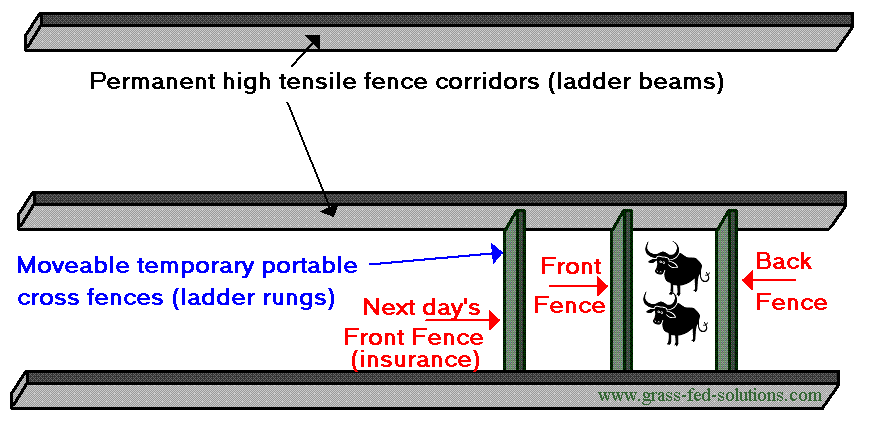Sustainable Farming Tips
for the beef cattle industry
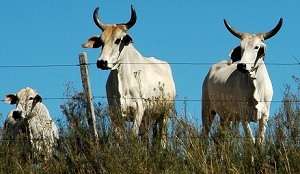
Image Credit: Valerio Pillar, Flickr, CC BY-SA 2.0
As sustainable farming practices become increasingly important to beef consumers, it is worthwhile to understand what sustainable cattle farming actually looks like - from a farmer's perspective. There is a right approach and a wrong approach to natural, organic, or sustainable cattle farming - this article will explain them both.
Farming is a business. Whether organic, natural, ecologically-sustainable farming, or completely conventional - the bottom line is that the farmer only survives if she can turn a profit. Sustainable farming is not just about nature - it's also about money. The best of intentions don't pay the bills.
Only a business strategy where 'cash in' is greater than 'cash out' is sustainable.
And that is where the trouble often starts for many farmers trying to switch from conventional to sustainable farming practices, because the "natural" alternative to most common agricultural products are astronomically more expensive than their conventional version.
The Danger of Adopting a 'Product-Replacement' Approach to Sustainable Farming
The typical approach that many farmers take when switching to organic, natural or sustainable farming methods is to begin looking for organic or natural alternatives to the agricultural products that they are accustomed to relying on to make their business work.
This is the "product replacement" farming strategy.
- Replace the conventional fertilizer with fertilizers approved for organic production.
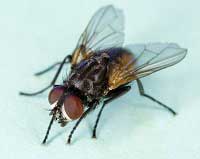
Image Credit: USDA, Flickr, CC BY 2.0
- Replace the parasite
control products with natural alternatives.
- Replace the herbicides and natural products, or mechanical weed control strategies.
- Replace the cattle feed ration with 'certified organic' forages and grains.
And so on - I think you get the picture
But this strategy doesn't work. Costs immediately spiral completely out of control.
And in many cases, the natural products simply do not get the job done.
...
There is another approach, which keeps costs in check and solves the day-to-day farming challenges from a completely different angle. But it requires a redesign of the farming strategy - from the ground up - after digging a little deeper into the science of how cattle, grass, and soils work.
It takes some extra initial planning, but once you put this alternate strategy into practice, you'll find it is extremely simple, saves buckets of money, makes your cows happier, makes your life as a farmer much easier, and all while being much more sustainable and environmentally-friendly than the "product replacement" approach.
But before I explain this approach, I am going to take a moment to explain why the "product replacement" farming strategy is so ineffective.
Why simply replacing conventional agricultural products with organic or natural alternatives is not a viable sustainable farming strategy for cattle farmers.
It's not that organic or natural products don't work.
- Organic fertilizer sources do generally contain fertilizer elements required by the soil.
- Most natural health remedies (excluding homeopathic remedies) do contain active ingredients.
- Most mechanical weed control do disrupt the weed life-cycle.
- And most natural parasite control methods do put parasites at a disadvantage.
But the problem is that in most cases the dosages are variable and inconsistent because you are dealing with natural sources:
- Most organic fertilizer sources are bulky, low-dosage, slow-release fertilizers where the nutrient availability is difficult to calculate for any individual crop. Furthermore, they are extremely expensive to apply in large dosages. And those farmers who rely heavily on manure and/or compost also find costs spiraling skyward because manure is expensive to handle, compost, and spread, not to mention all the capital that is sunk into equipment, which could have otherwise have been used to buy more land and more cattle.
- Many natural health remedies and natural parasite control products have highly-inconsistent results, are complicated, or prolong animal suffering because the parasite infestation remains unsolved. They simply do not produce consistently-verifiable responses in laboratory tests; thus treatment protocols are unclear, leaving farmers to experiment with dosages while their cattle hope for the best that their suffering will end sooner rather than later. One of the common issues with these natural health remedies is that many are plant-based, which means that the active ingredients will vary considerably from plant to plant (today's correct dosage may not be correct tomorrow!) and the plants generally also contain many other biochemical compounds that may have other completely different side effects and unintended consequences.
- Most mechanical weed control methods (like mowing, tine weeders, etc) require a great deal of labor, equipment, and fuel to be used effectively. And again that is time and capital not spent on buying more land and expanding the cattle herd. Despite how easy it is to buy tractors and mowers, and drive them out into the field every time the thistles get out of hand, that is yet another reason why costs spiral out of control.
Don't get me wrong - natural fertilizers, natural disease control, natural weed control, and natural parasite control methods DO have their place in a sustainable farming strategy - but what is important to understand is that they are not the heavy artillery in the farmer's toolbox. These methods tend to work best as gentle nudges, in an overall production strategy that is already mostly working well. To use the analogy of a car on a highway - they tend to work to help keep the car on the road, but are not so useful or cost-effective at cleaning up once there's already been an accident.
In other words, they work better in a preventative role, rather than as a heavy-handed cure.
Unfortunately, the 'traditional strategy for raising cattle' that most farmers take for granted for raising beef cattle requires some pretty heavy-handed cures to keep the business 'on the road'. Calving in the spring mud, bunching cattle together in feed pens, making forages, set-stock grazing (no grazing rotation), etc - are all farming practices that need to be supported by a steady supply of fertilizers, pesticides, herbicides, and antibiotics to keep the farmer out of trouble.
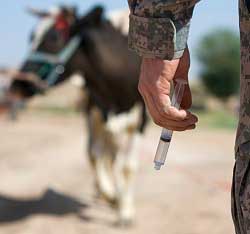 An ounce of prevention is worth a pound of cure.
An ounce of prevention is worth a pound of cure.Image Credit: ResoluteSupportMedia, Flickr, CC BY 2.0
Once the cattle have worms or are plagued by botflies, once the soil fertility is out of balance, once the weeds have begun taking over the pasture, or once the cattle are sick with scours, natural remedies simply don't have the heavy-handed punch to put a full-stop to the problem NOW. From the cattle's viewpoint, this prolongs unnecessary suffering. From the business viewpoint, that means crop yields will suffer and/or time, labor, fuel, and precious capital will all be tied up for extended periods unless a solution can be found PRONTO.
Trying to solve these problems with the gentle nudges of natural remedies gradually sucks the live-blood out of any farm's financial sustainability, no matter how well-intended this "product replacement" farming strategy may be.
But, as I alluded to earlier, there is another strategy for farmers looking for a more sustainable farming method. It requires a complete REDESIGN of the farm plan. It is about rethinking the farming strategy from the ground up. ELIMINATE the need for as many of these products as possible by creating a farm ecosystem that eliminates problems BEFORE they begin. And those problems cannot be eliminated altogether are restructured by addressing their root causes so that a limited dose of the more expensive natural products can step in with gentle nudges to keep the system on track.
That sounds lovely, but terribly academic. What does this actually mean in practical terms?
The Sustainable Farming Strategy - rethinking cattle farming from the ground up
Rather than getting into a complex discussion about how to design the farm ecology based on nutrient cycles, parasite life-cycles, cattle physiology, and the mechanisms of disease, let's look at some hands-on practical examples of how to redesign the farming strategy from the ground up!
Let's get our hands dirty and see what sustainable farming looks like out there in the cattle pastures.
Example # 1: Calving Season
I'll start with one of my favorite sustainable farming strategies - the calving season - and how to re-structure calving to effortlessly reduce calf death losses and post-calving diseases even as you reduce the amount of time and effort that you spend watching over your cattle herd.
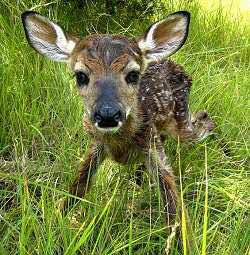 Time your calving season to match when wild grazing animals calve in your region.
Time your calving season to match when wild grazing animals calve in your region.Image Credit: Clay Junell, Flickr, CC BY-SA 2.0
It is so simple. Change your calving date. Calve on green growing pastures, during the growing season, timed to coincide with the date that the deer, moose, antelope or other grazing species calve in your area.
The deer fawn in the image on the right can teach you volumes about what is the most ideal date for your farm's calving season!
This simple change has a wide-reaching positive domino effect on your farm. When calves are born onto green grass and warm pastures instead of mud, snow, and frost, it doesn't take a rocket scientist to see why diseases melt away, frozen ears and toes become a distant memory, and health and survivability increases dramatically in your cattle herd, all without lifting a finger. But the benefits don't stop there - you'll find yourself having to pull far less calves and your barn will remain largely empty during calving season. Udders stay clean and you won't need to create bedding piles or calf shelters any more.
Switching the calving date is the single most important change that you can make to your cow-calf herd to reduce costs, while eliminating the need for pharmaceutical interventions and increasing your farm's profitability. Calving date is a perfect example of how a little bit of simple planning can replace a whole arsenal of agricultural products.
Follow the links to learn more about the benefits of calving on pasture, how to choose the ideal calving date, and how to manage your calving season in the midst of a pasture rotation.
Example # 2: The Daily Pasture Rotation
Another extremely powerful sustainable farming strategy is to switch your rotational grazing management to using DAILY pasture moves.
This means setting up a smart electric fence grid in your pastures specifically designed to make DAILY pasture moves feasible. This simple change of giving your cattle a fresh new slice of pasture every day once again triggers an avalanche of positive repercussions.
It is such a simple system. Set up your pastures as single-wire broad permanent fence corridors, which you then ration out as daily grazing slices (which will vary in size from day to day in sync with changing grass growth rates throughout the year) using three short portable single-wire electric cross-fences, which follow along with your cattle herd. One fence behind, one in front, and a third wire to set up the next day's grazing slice in advance, so if the cattle bust through the front fence, they'll only spoil a single extra day's grazing.
The simplistic version looks like this:
Follow this link to learn more about how to build this smart electric fence grid and how to get water to every single day's grazing slice.
The consistent daily nutrition of using daily grazing slices (plus the increased competitiveness this causes in your cattle herd) increases daily cattle weight gains. A lot!
Meanwhile, parasite problems decrease all on their own because manure pads (which incubate flies) are left far behind the grazing cattle herd.
Weed pressure reduces because the cattle graze more indiscriminately, which puts grass at a competitive advantage.
Pasture yields increase without adding still more fertilizer. In fact, fertilizer needs will decrease because manure is spread evenly behind the grazing cattle herd and stays on pasture where it belongs instead of accumulating in favorite bedding sites and under shade trees.
And soil moisture evaporation decreases because not grazing grass so short means that the soil is rarely exposed to the sun, which decreases irrigation costs (or increases pasture yields in non-irrigated pastures).
Implementing a DAILY pasture rotation with this style of fencing and pasture management is a true win-win strategy. It is MUCH cheaper than any other style of cattle fencing, while simultaneously addressing so many other aspects of cattle farming through the simple act of how you set up and operate your pasture rotation. It is another perfect example of how planning - this time through the grazing strategy - can replace yet another large swath of your agricultural product arsenal.
Example # 3: Learn how to extend the grazing season into the winter months
Winter grazing is the art of creating high quality winter pastures so you can extend your grazing season deep into the winter months, long after the end of the growing season.
Winter Grazing Caveat
While extending the late-autumn grazing season is possible with any cattle herd, a cow/calf herd can only safely be grazed through the entire winter if it also has had its calving season shifted to calve on pasture during the growing season, as discussed in the first example above.
Furthermore, the length of the winter grazing season depends on your skill at creating high-quality winter pastures as well as your monthly forage analysis program - all part of the planning that goes into making this strategy possible.
Follow the link to learn more cattle nutrition tips that make winter grazing possible.
It doesn't take a rocket scientist to see that any time you can use your grazing cattle to replace the need for tractors, harvesters, hay sheds, and feed wagons, it will save you money. Loads of it. Winter feed is the single biggest cost of raising cattle. And winter grazing is the grass-fed solution to cattle feeding.
But the positive domino effect doesn't stop there. The longer you continue your grazing rotation, the more manure stays right in the pasture where it belongs instead of accumulating in winter feed pens. This in turn reduces fertilizer bills and manure handling costs.
And cattle in a winter grazing program can bed down in fresh pasture every night, even in the snow, so you don't need cattle bedding as long as your pasture rotation can continue during the winter.
Then there are the health-advantages. A fresh slice of winter pasture every day means cattle are not exposed to the large manure build-ups that are a common feature in most winter feed pens. When cattle are able to continue their winter pasture rotation instead, common diseases like pneumonia, which often show up in late autumn just as the cattle transition from pasture to feed pen, simply don't seem to show up. Why should they? - Fresh pasture and a clean place to sleep every night naturally puts disease at a disadvantage.
However, unlike the first two examples, this sustainable farming strategy is not something that you can implement overnight. Rather, it is something you grow into by learning how to create high-quality winter pastures and then progressively extending the grazing season a little further each year as your experience with this sustainable farming strategy grows.
Whole-Farm Redesign instead of Product Replacement Strategy.
Each of the sustainable farming examples listed above was not a single-issue approach - use product XYZ for this problem or product ABC for that problem.
Rather, each involved a comprehensive restructuring of the cattle farming strategy, from the ground up, to take advantage of how cattle, soil, grass, weeds, and parasites function - designing the day-to-day routine of your farm to put what you want at an advantage and putting what you don't want at a disadvantage.
With this approach to sustainable farming, the challenges seem to melt away, seemingly by themselves.
It doesn't mean you'll never have another parasite, disease, or weed on your farm. But it does mean that their frequency will be greatly reduced so your costs remain in check, their intensity will be greatly reduced so that the majority will be solvable through the gentle nudges of natural or organic agricultural products, and you can reduce the times when you need to reach for the heavy-hitters in your farming toolbox.
Planning has replaced time, effort, diesel fuel, fences, equipment, and bills from your agricultural product suppliers.
Re-designing a comprehensive whole farm production strategy, from the ground up, is the key to making a successful transition to natural, organic, or sustainable farming methods.
And this approach is not just for organic farmers or farmers looking to profitably direct-market their grass fed beef to health-conscious consumers.
It is equally relevant to traditional cattle farmers producing beef for the commodity markets - the cow-calf ranches, stocker-grazing operations, and cattle-finishing businesses - all of which can learn how to incorporate these low-cost ecologically-sustainable farming strategies into their businesses to reduce their production costs.
After all, less calving deaths means higher farm yields. Less disease means less time and less money spent on treating diseases. Manure that is spread efficiently by grazing cattle is manure that doesn't need to be spread by tractors even as it helps reduce the farm's fertilizer bill. And any strategy that lets a grazing cow replace the need for tractors, harvesters, and feed wagons is a strategy that will increase the farm's profit margin and financial sustainability.
Sustainable farming and lower production costs. It doesn't get any better than that!
Thumbnail Image Credit: Valerio Pillar, Flickr, CC BY-SA 2.0
Related Articles:
(Disclosure: I get commissions for purchases made using Amazon links in my post.) And when you're ready to start planning your cattle farm, check out my book: Grass-Fed Cattle: How to Produce and Market Natural Beef. Use the links below to explore my book and read reviews on Amazon: 
|

